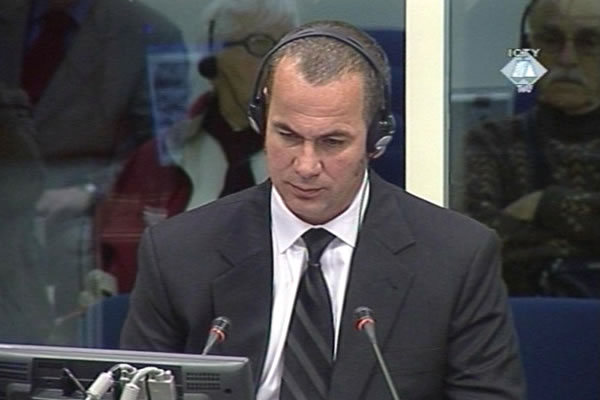Home
DEAD BODIES WERE RUN OVER BY TANKS
In his evidence at the trial of Croatian generals for crimes committed in the course of Operation Storm and its aftermath, Andries Dreyer, former security coordinator in the UN Knin base, described how Croatian soldiers drove over dead bodies in a tank. The bodies were those of persons killed in a mortar shell attack on the crowd that had gathered in front of the UN base on 5 August 1995
 Andries Dreyer, witness in the Gotovina trial
Andries Dreyer, witness in the Gotovina trial When the shelling of Knin began at dawn on 4 August 1995, Andries Dreyer, security coordinator in the UN Knin base, had to evacuate the personnel of the UN and other international organizations from the town and transfer them to the UN base. From 4,30 am to 6 pm he went to different parts of the town five times to pick up the personnel and transfer them to the base. On aerial photos of Knin, he marked every route he took highlighting locations where he saw shells impacts. Former member of the South African defense forces estimated that Knin had been shelled from multiple rocket launchers and 155 mm howitzers. In his view, the shelling was indiscriminate: the whole of Knin was a target.
Next day, 5 August 1995, several mortar shells hit the area in the immediate vicinity of the UN base where a crowd of civilians had gathered. The shells hit closer and closer to the base and the last one exploded right in the middle of the crowd in front of the base. In Dreyer’s opinion, this meant that the mortar crew was correcting its fire. Five or six persons were killed then and their bodies were put in body bags by the Canadian ‘blue helmets’ and left by the side of the road. When Croatian troops entered Knin that same day, soldiers took some of the bags with dead bodies, placed them on the road and drove over them in a tank.
The defense of general Ante Gotovina didn’t deny that there was an explosion in front of the UN base but it contended that a tractor trailer with Serbian soldiers carrying a large amount of weapons was hit. It gave notice to the Trial Chamber that it intended to present ‘at least two autopsy reports’ challenging Dreyer’s allegation about the tank.
Using the same aerial photos of Knin on which Dreyer marked his movement around the town and the sites where shells landed on 4 August, Gotovina’s defense marked the buildings it considered to be military targets. Among them are the army barracks, the bridge, tunnel for ‘armored trains’, the main intersection, the railway station, the SVK General Staff, the government and assembly buildings, factories, warehouses and even the nursing home. According to the defense, this building was used as the quarters for officers seconded to the SVK from Belgrade.
Locations that the defense considers as legitimate military targets corresponded to a considerable extent with the areas where the artillery fire was concentrated, as marked by Dreyer. The witness added that he had seen evidence of shelling everywhere he went around Knin on 4 August 1995. The Trial Chamber will, of course, decide what were and what were not legitimate military targets in this case.
Linked Reports
- Case : Gotovina et al. - "Operation Storm"
- 2008-04-16 AUTHORITIES COULD HAVE PREVENTED ARSON AND LOOTING
- 2008-04-15 WHO SHELLED KNIN?
- 2008-04-14 HOW MANY DEAD IN KNIN HOSPITAL?
- 2008-04-22 ‘INDISCRIMINATE AND DELIBERATE’ SHELLING OF KNIN
- 2008-04-23 GENERAL LESLIE UNDER FIRE FROM GENERAL GOTOVINA’S DEFENSE
- 2008-04-24 CROATIAN ARTILLERY WAS ‘BAFFLING’
